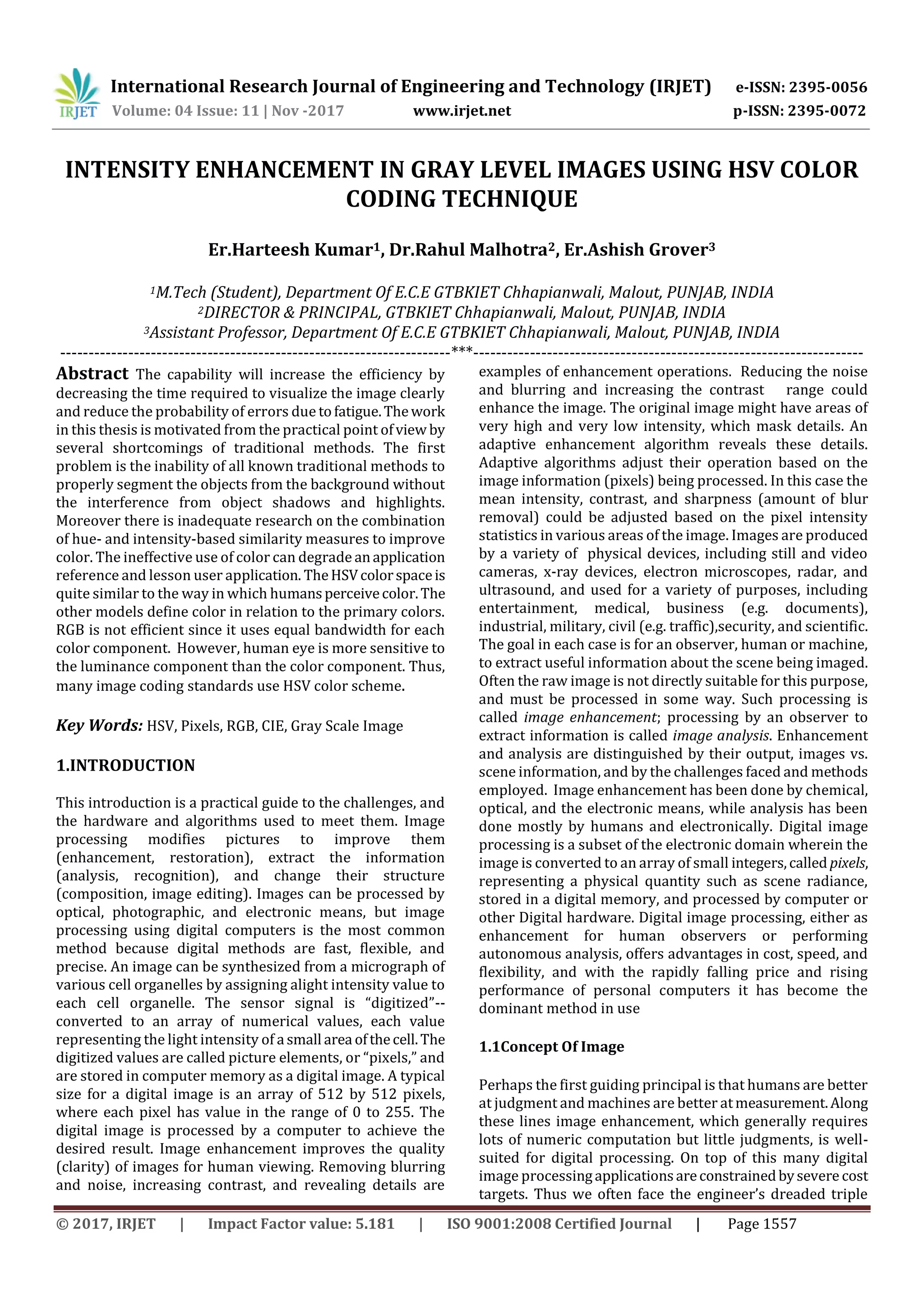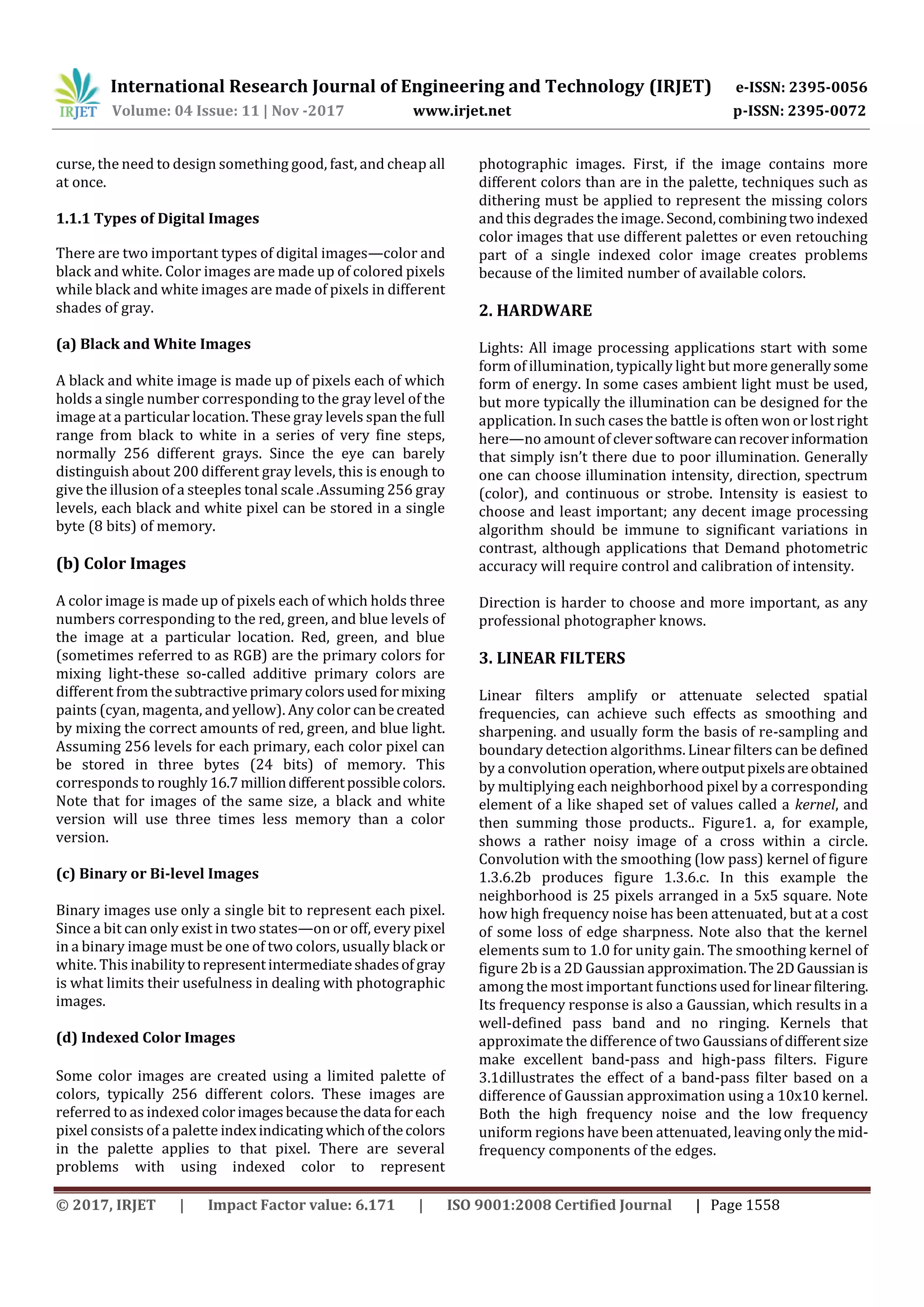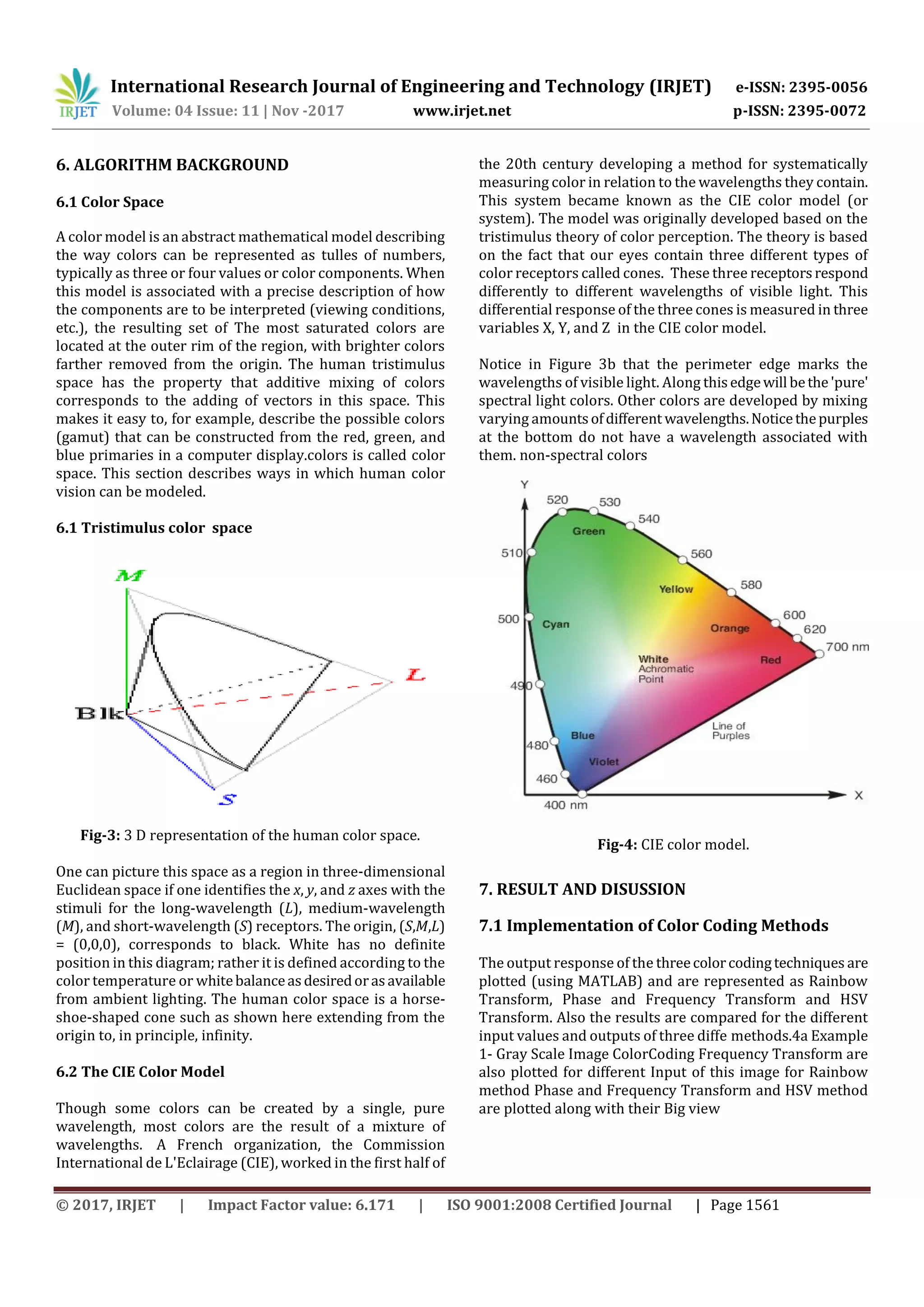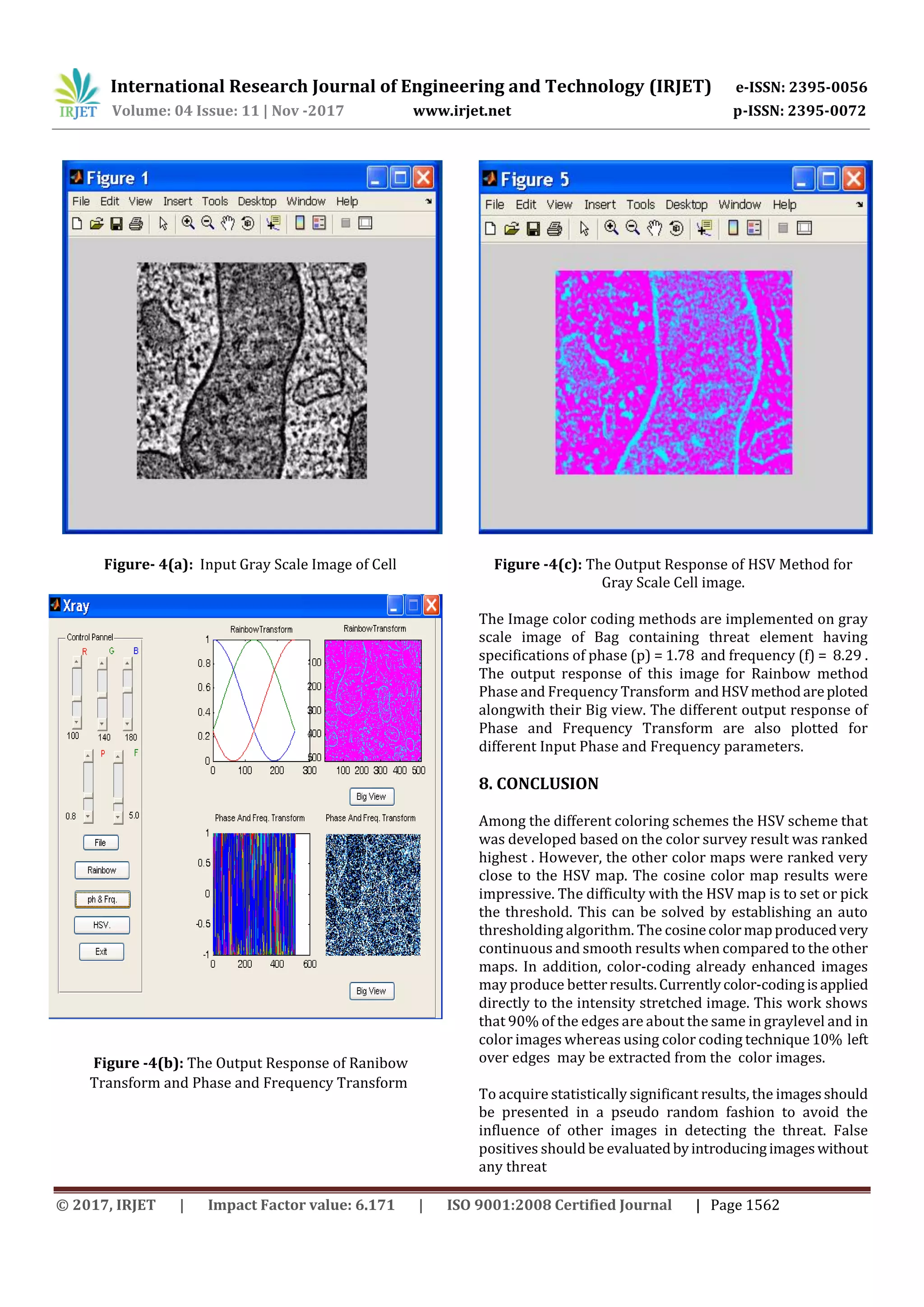This document discusses techniques for enhancing the intensity of gray scale images using HSV color space coding. It begins with an abstract discussing the motivation to increase image clarity and reduce errors from fatigue. Section 1 provides an introduction to image processing and enhancement. Section 1.1 discusses digital images, including types such as black and white, color, binary, and indexed color images. Section 2 covers hardware used in image processing like lights. Section 3 discusses linear filters that can perform operations like smoothing and sharpening through convolution.


![International Research Journal of Engineering and Technology (IRJET) e-ISSN: 2395-0056 Volume: 04 Issue: 11 | Nov -2017 www.irjet.net p-ISSN: 2395-0072 © 2017, IRJET | Impact Factor value: 6.171 | ISO 9001:2008 Certified Journal | Page 1559 Figure-1: An image enhanced to reduce noise or emphasize boundaries. Physiological Factors Color is determined by an interaction among three photo pigments; the perceived color is a mixture of the relative responses of the red, green, and blue photo pigments, in much the same way as a television camera creates color [4]. Given a dramatic imbalanceamong the percentages ofcellscontainingred(approximately 64%), green (approximately 32%), and blue (approximately 2%) photo pigments, it is clear that the perception ofcolorisboth highly specialized and physiologically biased (data from March, 1988). Color results from the interaction of light with the nervous system. There are several components that affect color perception, including the eye lens, the retina, and a color processing unit along the optic nerve. These areas are discussed in the following sections. (a) Lens The function of the lens is to focus the incoming light on the retina, which contains the photoreceptors. Different wavelengths of light have different focal lengths. Therefore, for pure hues, the lens must change its shapesothatthelight is focused correctly. For a given lens curvature, longer wavelengths have a longer focal length, i.e., redisthelongest focal length and blue is the shortest. To have an image focused on the retina, the lens curvature must change with wavelength with red light requiring the greatest curvature and blue light the least curvature. This means that if pure blue and pure red hues are intermixed, the lens is constantly changing shape and the eye becomes tired. A related effect is called chromo here pure colors located at the same distance from the eye appear to be at different distances, e.g. reds appear closer and blues more distant. Sometimes pure blues focus in front of the retina and so appear unfocused. At night, a deep blue sign may appear fuzzy while other colors appear sharp. The lens also absorbs light about twice as much in the blue region as in the red region. As people age the lens yellows, which means it absorbs more in the shorter wavelengths. Therefore, the result is that people are more sensitive to longer nets, wavelengths (yellows and oranges) than they are to shorter wavelengths (cyan to blue)andtheseincreaseswithage. The fluid between the lens and the retina also absorb light and this effect increases as people age,sotheolder peopleget the less sensitive they are to light in general (the apparent brightness level decreases) and especially the sensitivity to blue decreases. (b) Retina The retina contains the photoreceptors that absorb photons and transmit chemical signals to the brain. There are two types: rods, which are night-vision receptors and have no color dependency, and cones, which have color sensitivity and require a higher level of light intensity than rods. Figure-2: Spectral sensitivities of the three classes of photoreceptors in the retina As shown in Figure2. there are three types of photo- pigments in the cones; "blue" with a maximum sensitivity at 430 nm, "green" with a maximum sensitivity at 530 nm, and "red" at 560 nm. (This wavelength actually corresponds to yellow). Light at a single wavelengthwill partiallyactivateall three types of cones, e.g. at a wavelength of 470 nm, blue is strongest plus some red and green components. The percentage of cones is not equal but is as follows: blue (4%), green (32%), and red (64%). In addition, the cones are differentially distributed in the retina. The center of the retina has a dense concentration of cones but no rods while the periphery has many rods but few cones. The color distribution is also asymmetrical. The center of the retinas primarily green cones,surroundedbyred-yellowcones, with the blue cones being mainly on the periphery. The center of](https://image.slidesharecdn.com/irjet-v4i11284-171213071559/75/Intensity-Enhancement-in-Gray-Level-Images-using-HSV-Color-Coding-Technique-3-2048.jpg)
![International Research Journal of Engineering and Technology (IRJET) e-ISSN: 2395-0056 Volume: 04 Issue: 11 | Nov -2017 www.irjet.net p-ISSN: 2395-0072 © 2017, IRJET | Impact Factor value: 6.171 | ISO 9001:2008 Certified Journal | Page 1560 the retina has no blue cones. Objects are seen by edge detection, where an edge can be created by a difference in color or brightness or both. Edges formed by color differences alone, with no brightness differences, appear fuzzy and unfocused, so changes in brightness should be added to get sharp edges. Photoreceptors adjust their sensitivity to the overall light level, e.g. going into or out of a dark room require some adjustment time. There is also a requiredminimumintensity level for the photoreceptors to respond. This minimum varies with wavelength with the highest sensitivity in the center of the spectrum. Therefore, blues and reds must have a higher intensity than greens or yellows in order to be perceived. (c) Brain From the retina, the optic nerve (actually a collection of nerves) connects to the brain but before it reaches thebrain, there is a color-processing unit, called the lateral geniculation body. This recombines the RGB color information into three new channels as Follows: R-G gives red or green color perception R+G gives the perception of brightness and yields yellow(Y) Y-B gives yellow or blue color perception Thus, blue plays no part in brightness so thatcolorsdiffering only in amount of blue don't produce sharp edges. Also,note that since blue and yellow and red & green are Linked together it is impossible to experience combinationssuchas reddish green or bluish yellow. (d) Color blindness About nine percent of the population has some kind of color perception problem. The most common is red-green deficiency, which can arise froma deficiencyof eitherthered or the green photo-pigments. These people have difficulty distinguishing any color that is dependent upon the red: green ratio. 4. GENERAL GUIDELINES BASED ON PHYSIOLOGY These are some of the guidelines drawn from Munch [5] principles based on physiology. Avoid the simultaneous display of highly saturated, spectrally extreme colors. This causes the lens to rapidly change shape and thus tires the eyes. Desiderate the colors or else use colors that are close together in the spectrum. Pure blue should be avoided for text, thin lines, and small shapes. Since there are no blue cones in the center of the retina, these are difficult to see. But blue makes an excellent background color, e.g. for a computer display it tends to blur the raster lines. Avoid adjacent colors that differ only in the amount of blue. Since blue doesnot Contributetobrightness, this creates fuzzy edges. Older operators need higher brightness levels to distinguish colors. Colors change in appearance as the ambient light level changes. The magnitude of a detectable change in color varies across the spectrum. It is difficult to focus upon edges created by color alone. Avoid red and green in the periphery of large displays. Opponent colors go well together. For color-deficient observers, avoidsinglecolordistinctions. Color selection guidelines based on human color vision Avoid adjacent areas of strong blue and strong red in a display to prevent unwanted depth effects(colorsappearing to lie in different planes). Never use the blue channel alone for fine detail such as text or graphics. Do not use, for example, blue text on a black background or yellow text on a white background. Areas of strong color and high contrast can produce after images when the viewer looks away from the screen, resulting in visual stress from prolonged Viewing. Do not use hue alone to encode information in applications where serious consequences might ensue if a color-deficient user were to make an incorrect Selection. 5. PSYCHOLOGICAL FACTORS As well understood as the physiology of color is, this factor provides little explanationforouropinionsofcolorandcolor combinations. At the very least, opinionsofcolorarelearned and highly associative. For example, as children, we often had a “favorite color” and we liked everything: clothes, toys, books that matched our preference. Over time, we learned a variety of color schemes and in most cases, our tastes become more refined. But even as adults, we are influenced by fashion, and may still associate our more sophisticated sense of color with increasingly more sophisticated emotions, desires, or impressions. For example, even a cursory examination of changes in interior design from the 1950s to the present reveals a dramatic evolution of what was considered warm or even comfortable colour.](https://image.slidesharecdn.com/irjet-v4i11284-171213071559/75/Intensity-Enhancement-in-Gray-Level-Images-using-HSV-Color-Coding-Technique-4-2048.jpg)


![International Research Journal of Engineering and Technology (IRJET) e-ISSN: 2395-0056 Volume: 04 Issue: 11 | Nov -2017 www.irjet.net p-ISSN: 2395-0072 © 2017, IRJET | Impact Factor value: 6.171 | ISO 9001:2008 Certified Journal | Page 1563 REFERENCES [1] Kerr.S.T , “ Review and analysis of color coding research for visual displays, Human factors”, (ERIC Document Reproduction No –ED 285 545),Feburary 1987. [2] Wright .P and Lickorish .A ," Color in document design”, IEEE transactions on Professional Communication , 34(3), 180-185. [3] Lawerence.J. Najjar ,"Using color effectively”, (IBM TR52.0018). Atlanta, GA: IBM Corporation, January 1990. [4] Faiola.T, “Principles and guidelines for screen display interface: The Videodisc Monitor”,8(2) ,27-29. [5] Horton.W ," A guide to the confident andappropriate use of color”, IEEE transactions onProfessional Communication, 34(3), 160-171. [6] Michael J. Swain ," Color Indexing” International Journal of Computer Vision, 7:1, 11-32 , June 1991. [7] Durrett.J ,"How to use color displays effectively “, The elements of color vision and their implications,Pipeline7(2) ,13-16. [8] Shneiderman .B ," Designing the user interface :The strategies for effective human computer interaction “, 2nd edition ,1992. [9] H.Tang ,"Monochrome Image Representations and Segmentation based on Psuedo-Color “,CA85594 (EXW)and NIH R29 14715 (DG)., 1993.](https://image.slidesharecdn.com/irjet-v4i11284-171213071559/75/Intensity-Enhancement-in-Gray-Level-Images-using-HSV-Color-Coding-Technique-7-2048.jpg)